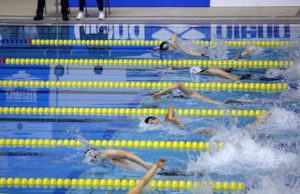 Most swimmers have a side that they are most comfortable breathing to. Bilateral breathing is swimming jargon for breathing to both sides and appears to be a very controversial topic in the swimming world.
Most swimmers have a side that they are most comfortable breathing to. Bilateral breathing is swimming jargon for breathing to both sides and appears to be a very controversial topic in the swimming world.
Bilateral breathing is thought to help develop a more symmetrical stroke. Some argue that many stroke flaws may develop when you breathe to one side. Such stoke flaws may include crossovers, scissor kicks, timing problems, poor catch technique – which may contribute to, or even cause, shoulder injuries.
When you only breathe to your dominant side, you will rotate poorly on your non-dominant side. Poor rotation can cause your recovering arm to swing low over the water and the swinging momentum of that arm causes it to cross the midline. This results in a lopsided stroke and poor efficiency.
Do elite swimmers practice bilateral breathing? It’s common for elite swimmers to breathe to one side when they are racing – often to keep an eye on an opponent, or in open water to avoid looking towards the sun or into waves. However, they will often practice bilateral breathing while they are training in order to keep their stroke technique symmetrical and avoid injury.
Here are a few different ways to try bilateral breathing:
- Breathe every 3 strokes (or every 5 or 7) i.e. swap sides every time you breathe.
- Breathing 2-3 times in a row to one side before swapping to the other side.
- Breathing one side for a full length of the pool before swapping sides.
Try adding some bilateral breathing into your swimming training – it will help you develop a more symmetrical stroke, help reduce risk of injury and train your respiratory system to manage its oxygen intake more efficiently.
If you have a niggly shoulder from swimming, come in and see your Physiotherapist at Bend + Mend in Sydney’s CBD for more specific injury management and advice.





